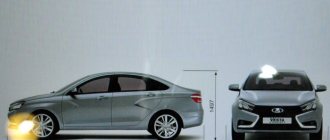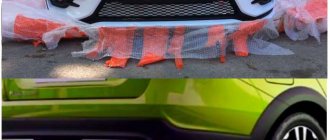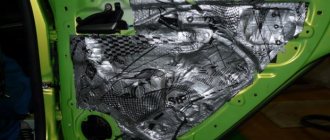AvtoVAZ has not had such a model as the Lada Vesta for a long time, one might say never. The car is a technological breakthrough for VAZ. Vesta meets the requirements for modern cars. The car has a stylish and recognizable design. For any car, many parameters are important: engine, trunk size, wheel size, but the interior—where the driver is constantly located when driving the car—remains an important factor when choosing. Vesta is a beautiful car on the outside, but let's look inside and see what's there. Lada Vesta is made using new plastic materials. For the first time in a VAZ car there are several interior variations!
- Sedan interior
- Photo of the interior of the sedan modification
- Dimensions of the Lada Vesta interior and comparison with competitors
- Salon Lada Vesta SV cross
- Vesta Cross interior colors
- Salon Vesta SV
- Salon Vesta Sport
- Interior of Lada Signatur (Long)
Photo of the interior of the sedan modification
Inside the Lada Vesta car, materials and innovations were used that had not been used on a vase before. This made overall operation more pleasant for people; for the first time on a vase, the steering column could be adjusted for reach and installation angle. The steering wheel can be adjusted for reach by 50 mm and angle by 7 degrees. Vesta now has a multifunction steering wheel, which was not previously available on any VAZ model. The steering wheel has a three-spoke badge in the middle, it looks made with high quality and accuracy! The steering wheel has control buttons for the cruise control radio and telephone.
The instrument panel is interestingly implemented; it is grouped into three wells, all of which resembles a sports car. The quality of the panel material is good. The panel has few lamps, but despite this it looks informative. The torpedo is made of dark plastic. The center console is level with the panel, but protrudes forward a little and this is convenient for use; you don’t need to reach out to press a certain button. The console is divided into two parts, but depending on the configuration, it is located on top (in the expensive configuration there is a multimedia system with a 7-inch screen), and a branded radio in the cheaper basic version. On the second part of the panel there is a climate system separated by a row of buttons. The central tunnel is equipped with two cup holders.
The car has good visibility; the arches do not interfere with the view, as on the previous model 2170. Two airbags are built into the front panel (driver plus passenger). Regarding the interior trim, it looks high quality. The door cards, by the way, use new Soft Look plastic, are visually similar to leather. The plastic is embossed and hard to the touch. Despite the cheap materials, the interior looks quite strict and not childish, and if the car is in the Luxury configuration, the interior is equipped with additional chrome inserts. In general, Vesta’s interior looks a class higher than it is: ergonomic seats with good upholstery, all instruments and elements are arranged thoughtfully. When you get into the car, it’s pleasant to be in, you can see the road, and it’s easy to read the information on the speedometer. The seats have a high depth of adjustment, which allows tall people to feel comfortable behind the wheel. In previous models, there was limited space in the back, which was a big minus. There is ample knee room behind the driver; the distance from the rear sofa to the front seats is 226 mm. In general, it feels like the dimensions inside the car have been thought out. The seats are comfortable, the headrest follows the lines of the body and is friendly with the back of the head when standing in a traffic jam. The distance from the floor to the rear sofa is 345 mm, and from the floor to the top of the front seats is in the range from 276 to 310 mm. The distance from the floor to the steering wheel (since it is adjustable) is from 450 - 528 mm.
Serial photos of Lada Vesta from the plant in Izhevsk
We have already reported more than once about receiving photographs from the plant in Izhevsk. So, in order, what we have.
Workers managed to capture one of the first assembled versions, which stood in the workshop in Izhevsk to be shown to managers
Back view. Someone even sits inside the cabin and looks at the new product
After a while, the management of AvtoVAZ and IzhAvto decided that it was time to “warm up” the audience a little and posted an official photo.
But recently we managed to get pictures of the Lada Vesta painted in new colors.
Photo of a car in Mystery color
“Lux” package. Lemon color. A very bright and unusual color for Lada. We think that young girls (and some guys) are the target audience for this color
Also an interesting “youth” color called “Amethyst”
photo of a manual transmission knob
This is what the handbrake of the future new product looks like
Photos of Lada Vesta
Exterior photo of Lada Vesta - appearance
From the outside, a sharp transition from the old school of design to the new one, led by Steve Mattin, is immediately visible. He managed to turn the familiar and discreet VAZ into a stylish and extravagant car that makes people turn around on the street.
Dimensions of the Lada Vesta interior and comparison with competitors
As a basis for comparison, let's take the interior of the closest 4 competitors of our Vesta. The distance from the front seat (when the driver is sitting in it) to the ceiling is 1020 mm. If we take the competitors, then only Logan wins, it has 1030 mm, Solaris has 1015, Ravon Gentra 1015, Polo has a modest 1010 mm. The distance from the pedals to the knee and to the back of the front seat, depending on the height of the person, is in the range: 975-1175; Logan has a distance from 960 mm to 1190; Hyundai Solaris has from 970 to 1190; Ravon has numbers from 965-1145; Polo 955-1150. Interior height in the middle of the car: Lada Vesta – 1190 mm; Logan - 1210 mm; Solaris – 1200 mm; Ravon – 1170 mm; Polo – 1180 mm. The distance from the rear sofa (with a passenger) to the ceiling is 2180-925 mm; by the way, the Solaris is the same. Ravon has 960 mm, just like Logan; Polo-935 mm Distance from the back of the rear row to the front seat: Vesta from 610 to 850 mm; Logan from 645 to 855 mm; Solaris from 565 to 810 mm; Ravon from 660 to 890 mm; Polo from 632-880 mm. It is clear from the numbers that our car is not the tightest.
Profile - side view
A photo of the Lada Vesta from the side no less expressively demonstrates the beauty of the new product. In general, the side part is made quite utilitarian - the roof is slightly tilted back, the doors are medium-sized, the feet climb onto the rear fenders. All this is familiar from a lot of other models. But the highlight lies in the expressive curves made in the shape of the same letter “X”. In the photo it is noticeable that the sides “begin” on the front and rear wings, and the curves run along the front and rear doors, respectively. These stampings are made very clearly.
Salon Lada Vesta SV cross
Since the cross body car came out at the end of '17, its interior is no different from the '18 car. Both the driver and the passenger feel comfortable sitting in the Cross. Many people are interested in the question of whether the Lada Vesta has 7 seats, the answer is: it doesn’t, there are no 7 seats in the interior of the crossover, there are only 5 of them.
Let's start with the Cross steering column; outwardly it is no different from the steering wheel of a Vesta sedan - all the same buttons for controlling the multimedia system. However, there are differences: in any configuration of the Vesta Cross, the steering wheel is covered with leather.
Photo of the interior of the cross modification
The central panel is no different from the sedan, everything is still harmoniously located in its place, which makes driving easier. There is a glove box mounted on the panel on the right; it has a decent volume. In the center of the cabin there is a central tunnel with cup holders and a gear knob. The handle of the box depends on what kind of box is on the car.
After the gearbox there is an armrest, convenient for the elbow of the right hand. The plastic in the cabin is the same everywhere, in the door cards and on the dashboard. Door cards have harmonious inserts that highlight the design. The doors have spacious containers in which you can put small things or a bottle of drink. Overall the door finish looks decent. Each door has its own electric lift, and the driver's window control unit with rear door locking and mirror adjustment.
The Vesta Cross floor is carpeted everywhere. It can be called a classic flooring material in many foreign cars and vases. The ceiling on Vesta Cross is light, but it is made with high quality; in case of contamination, the dirt can be easily washed off.
Price issue
The Luxury package is scattered in the price segment up to 106 thousand rubles. To be more precise, 8 positions are available to the buyer. We can’t talk about a slight difference between the trim levels. Each new price offers its own range of useful features that are sure to be useful to drivers.
The difference between the positions of the Luxury configurations is as follows:
- rear wheel disc brakes;
- armrest and USB for rear passengers;
- enhanced rear window tinting;
- heated rear seats;
- rear view camera and multimedia.
Regarding disc brakes, multimedia, there is no question that there is an overpayment for minor improvements. It is important for a modern driver to have confidence in the braking system, where one second of delay costs several tens of thousands of rubles for car repairs after an accident.
Salon Vesta SV
It is distinguished by poorer colors, for example, the SW station wagon does not have orange. Otherwise, the interior of the station wagon is similar to the cross.
Photo of SV salon
Exterior
One of the features of the top-end configuration of the car is R16 alloy wheels. The trunk contains a spare full-size 16" alloy wheel.
Other options will pleasantly surprise buyers: fog lights, illuminated entry and exit points in the front doors, a glossy black radiator grille and much more.
The bright color of the Lada Vesta is called “Lime”. This is an original palette, which is available in an option package only for Luxury trim levels.
Ease of configuration
However, the aesthetic appeal of the Lada Vesta’s interior is only half the success. The second half is the convenience of a beautiful interior, expressed in a lot of details.
The front seats, starting with the “Comfort” configuration, receive adjustable heating, and a productive and powerful air conditioner is built into the design itself. Passengers will not freeze in the car in winter and will not need open windows in summer.
The front seats are adjustable in angle from the basic version of the Lada Vesta. The driver's steering wheel in the same basic configuration can already be adjusted by rollout. Unfortunately, the ability to adjust both the seats and the steering wheel in terms of tilt, height, and rollout appears only when purchasing Vesta in the “Lux” assembly - however, the level of convenience allows this model to stand out among many others presented in the segment.
The manufacturer paid attention to safety. Starting with the Classic trim, the driver and all four passengers each receive a seat belt—which includes visible indicators if the passenger or driver is driving unbelted. The basic assembly includes a driver airbag and, optionally, a front passenger airbag. In subsequent trim levels, airbags for rear passengers also appear, and later - side airbags, which fix passengers and the driver in their places and prevent lateral sliding with subsequent impact.
Thanks to its customization capabilities, the car is comfortable even for fairly tall drivers and passengers (above 190 cm). Very few models presented in class B can boast of this. The Lada Vesta passed all the necessary crash tests, and the safety level of its interior was recognized as close to ideal (of course, for the maximum configuration).
Technical specifications
In the restyled Lada Vesta 2018
model year, the developers completely revised all the details and elements, so the model is considered an impeccable new design.
The car will be supplied only with a gasoline engine, there are three of them and all of them meet the Euro-5 standard.
- Gasoline unit 1.6 liters, capacity 106 liters. s., accelerates in 11.8 seconds, fuel consumption is 5.5 - 9.3 liters, the possible speed is 178 km/h.
- The unit is 1.6 liters, with a capacity of 114 hp. s., accelerates in 11.2 seconds, fuel consumption is calculated at 5.8 - 9.3 liters, speed is 178 km/h.
- The engine is equipped with a volume of 1.8 liters, a power of 126 horsepower, accelerates in 9.5 seconds, fuel consumption varies between 6.2-10.3 liters, and a speed of 180 km/h.
- Front wheel drive version.
In terms of transmission, the concern provides a 5-speed. Manual transmission and 5-speed robot with one clutch. Each of the presented motors is characterized by its own performance.
Other components
Vesta is equipped with a very effective windshield heater, which clears it of ice crust in just a few minutes (in Comfort trim levels and higher). Heated seats with convenient controls (all trim levels) are very effective - control buttons in the photo:
The Lada Vesta air conditioning system provides a good level of comfort even in difficult weather conditions. The dimensions of the illuminated and cooled glove box are quite normal.
The Czech-made ignition key is made in the German style, combined with an alarm remote control and the use of a folding spring-loaded working element allows the size to be reduced.
The car is equipped with an emergency call system via GLONASS with push-button control.
The shape of the armrest (in the Comfort package and above) between the front seats has been simplified in order to achieve greater manufacturability in production, but does not spoil the interior. At the same time, it is secured in three positions. For reasons of manufacturability, the shape of the head restraints has been changed towards simplification.
In addition to the handles, the doors of the Lada Vesta car have pockets, the sizes of which allow you to store various small items in them.
To ensure the safety of small passengers, the rear door windows only roll down halfway.
The cigarette lighter socket is complemented by a USB port located next to it, which is used when reading data into the multimedia system.
Due to the use of a large number of noise-insulating coatings inside the cabin, the Lada Vesta is quite quiet while driving, even on bad roads.
0 0 votes
Article rating
Headlights and lanterns
Even during tests in Italy, it was noticed that the head optics have too small a light spot, as a result we have poor road illumination at night. However, the headlights needed to be modified. Whether this is really true can be found out from the reviews of the owners.











